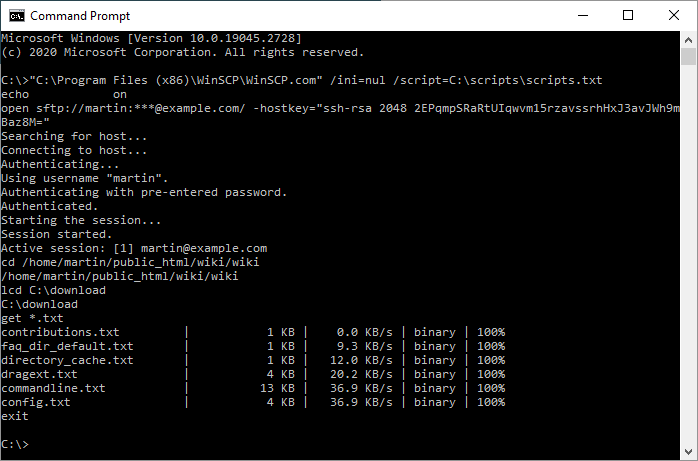This is an old revision of the document!
Scripting/Automation
This article contains detailed description of scripting/automation functionality. You may want to see simplified guide to the functionality instead.
In addition to graphical interface, WinSCP offers scripting/console interface with many commands. The commands can be typed in interactively, or read from script file or another source.
Advertisement
- Using Scripting
- Checking Results
- Commands
- The Console Interface Tool
- Verifying the Host Key or Certificate in Script
- Running a Script under a Different Account
- Example
- Further Reading
Using Scripting
See command-line parameters to learn how to enter the console/scripting mode.
For automation, commands can be read from a script file specified by /script switch, from standard input or passed from the command-line using the /command switch.
By default an interactive mode is used (the user is prompted in the same way as in GUI mode). To switch to a batch mode (all prompts are automatically answered negatively) use the command option batch on. For the batch mode it is recommended to turn off confirmations using option confirm off to allow overwrites (otherwise the overwrite confirmation prompt would be answered negatively, making overwrites impossible).
Multiple sessions can be opened simultaneously. Use the session command to switch between them.
Note that the first connection to an SSH server requires verification of the host key. Also the first connection to FTPS host with certificate signed by untrusted authority requires verification of the certificate.
Advertisement
Checking Results
WinSCP returns exit code 1, when any command is interrupted due to an error or any prompt is answered Abort (even automatically in batch mode). Otherwise it returns the exit code 0.1
To further analyze results of scripted operations, you will find XML logging useful.
Commands
The following commands are implemented:
| Command | Description |
|---|---|
| call | Executes arbitrary remote shell command |
| cd | Changes remote working directory |
| chmod | Changes permissions of remote file |
| close | Closes session |
| exit | Closes all sessions and terminates the program |
| get | Downloads file from remote directory to local directory |
| help | Displays help |
| keepuptodate | Continuously reflects changes in local directory on remote one |
| lcd | Changes local working directory |
| lls | Lists the contents of local directory |
| ln | Creates remote symbolic link |
| lpwd | Prints local working directory |
| ls | Lists the contents of remote directory |
| mkdir | Creates remote directory |
| mv | Moves or renames remote file |
| open | Connects to server |
| option | Sets or shows value of script options |
| put | Uploads file from local directory to remote directory |
| pwd | Prints remote working directory |
| rm | Removes remote file |
| rmdir | Removes remote directory |
| session | Lists connected sessions or selects active session |
| synchronize | Synchronizes remote directory with local one |
Advertisement
The Console Interface Tool
Learn about winscp.com, the console interface tool.
Verifying the Host Key or Certificate in Script
The first connection to an SSH server requires verification of the host key. To automate the verification in script, use hostkey switch of open command to accept the expected hostkey automatically.
You can find the key fingerprint on Server and Protocol Information Dialog. You can also copy the key fingerprint to clipboard from the confirmation prompt on the first (interactive) connection using Copy Key button.
FTPS certificate signed by untrusted authority may also need to be verified. To automate the verification in script, use certificate switch of open command to accept the expected certificate automatically.
Running a Script under a Different Account
If you are going to run the script under a different account (for example using the Windows scheduler), note that WinSCP may store its configuration to the user part of Windows Registry by default. So you may need to either transfer the configuration from your account registry to the other account registry or use the INI file instead.
Note that the configuration also includes verified SSH host keys.
Example
The example below connects to example.com server with account user, downloads file and closes the session. Then it connects to the same server with the account user2 and uploads the file back.
# Automatically answer all prompts negatively not to stall # the script on errors option batch on # Disable overwrite confirmations that conflict with the previous option confirm off # Connect using a password # open user:password@example.com # Connect open user@example.com # Change remote directory cd /home/user # Force binary mode transfer option transfer binary # Download file to the local directory d:\ get examplefile.txt d:\ # Disconnect close # Connect as a different user open user2@example.com # Change the remote directory cd /home/user2 # Upload the file to current working directory put d:\examplefile.txt # Disconnect close # Exit WinSCP exit
Advertisement
Save the script to the file example.txt. To execute the script file use the following command. As the script connects the session itself, using the command open, omit the session command-line parameter.
winscp.exe /console /script=example.txt
For simple scripts you can specify all the commands on command-line using /command switch:
winscp.exe /console /command "option batch on" "open user@example.com" "get examplefile.txt d:\" "exit"
Instead of using open command you can also open a session using a command-line parameter. Note that in that case session is opened yet before script starts. Particularly option commands do not apply yet. Generally you should avoid using this method.
winscp.exe /console /script=example.txt user@example.com
Further Reading
- When checking WinSCP exit code from batch file, make sure you are using winscp.com.Back
